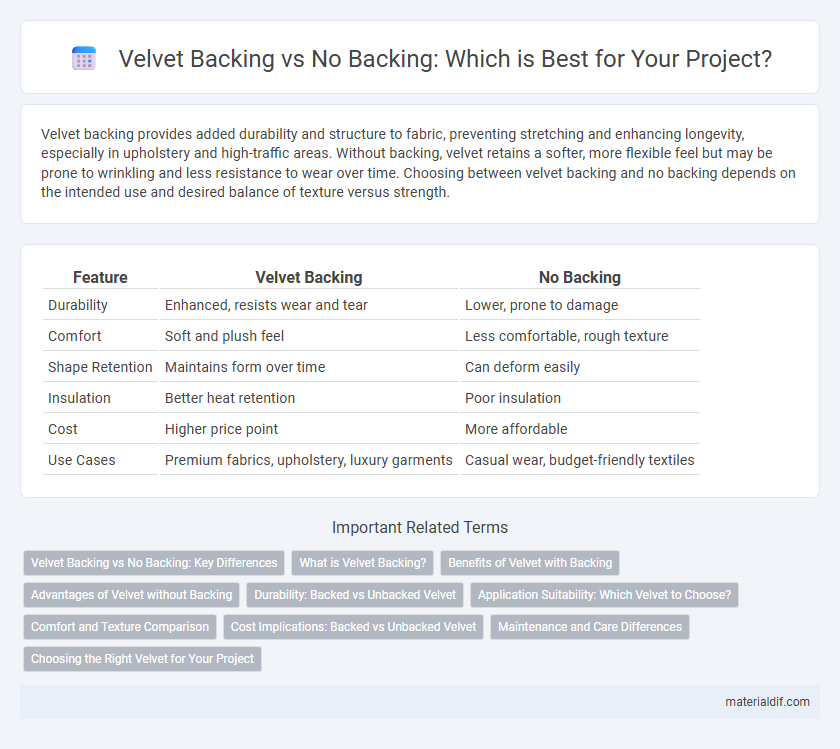Velvet backing provides added durability and structure to fabric, preventing stretching and enhancing longevity, especially in upholstery and high-traffic areas. Without backing, velvet retains a softer, more flexible feel but may be prone to wrinkling and less resistance to wear over time. Choosing between velvet backing and no backing depends on the intended use and desired balance of texture versus strength.
Table of Comparison
| Feature | Velvet Backing | No Backing |
|---|---|---|
| Durability | Enhanced, resists wear and tear | Lower, prone to damage |
| Comfort | Soft and plush feel | Less comfortable, rough texture |
| Shape Retention | Maintains form over time | Can deform easily |
| Insulation | Better heat retention | Poor insulation |
| Cost | Higher price point | More affordable |
| Use Cases | Premium fabrics, upholstery, luxury garments | Casual wear, budget-friendly textiles |
Velvet Backing vs No Backing: Key Differences
Velvet backing provides extra durability, enhanced texture, and improved structural support, making it ideal for upholstery and high-traffic areas, whereas velvet without backing tends to be more delicate and suited for low-use decorative applications. The presence of backing also affects the fabric's stretch resistance and stability, ensuring longevity and maintaining the plush appearance over time. Choosing between backed and unbacked velvet depends on the intended use, with backing offering practical benefits for everyday wear and tear.
What is Velvet Backing?
Velvet backing refers to a layer of fabric attached to the reverse side of velvet material to provide additional support, durability, and structure. This backing helps prevent stretching, distortion, and wear, making the velvet suitable for upholstery, cushions, and heavy-use applications. Without velvet backing, the fabric remains delicate and more prone to damage, limiting its functional versatility.
Benefits of Velvet with Backing
Velvet with backing provides enhanced durability and structure, making the fabric more resistant to wear and tear compared to velvet without backing. The backing adds stability, preventing stretching and sagging, which is especially beneficial for upholstery and heavy-use applications. This combination maintains the soft texture of velvet while improving its longevity and ease of maintenance.
Advantages of Velvet without Backing
Velvet without backing offers superior flexibility and a softer hand feel, making it ideal for garments that require lightweight drape and enhanced comfort. This type of velvet allows better breathability and natural stretch, which helps maintain the fabric's luxurious texture while reducing bulk. Its unstructured nature facilitates easier tailoring and customization, perfect for high-fashion and delicate apparel designs.
Durability: Backed vs Unbacked Velvet
Velvet fabric with backing significantly improves durability by providing extra support and resistance to wear, making it ideal for upholstery and high-traffic applications. Unbacked velvet, while softer and more luxurious to the touch, tends to be less durable and more prone to stretching and damage over time. Choosing backed velvet enhances fabric longevity by preventing deformation and maintaining texture integrity under frequent use.
Application Suitability: Which Velvet to Choose?
Velvet with backing offers enhanced durability and stability, making it ideal for upholstery and heavy-use applications where resistance to wear and tear is essential. Velvet without backing remains softer and more flexible, better suited for lightweight garments or decorative accents where comfort and drape are priorities. Choosing the right velvet depends on the intended use, with backed velvet favored for furniture and drapery, while unbacked velvet excels in fashion and delicate upholstery.
Comfort and Texture Comparison
Velvet with backing offers enhanced durability and a structured feel, providing improved comfort by preventing fabric stretch and maintaining shape over time. Without backing, velvet feels softer and more supple, allowing for a luxurious texture that drapes naturally but may lack support and longevity. Choosing between backed and unbacked velvet depends on the desired balance of comfort, texture, and fabric resilience.
Cost Implications: Backed vs Unbacked Velvet
Velvet with backing increases production costs due to additional materials and manufacturing steps, resulting in higher retail prices compared to unbacked velvet. Unbacked velvet, while more affordable, may require extra care to prevent damage and offers less durability for heavy-use applications. Choosing between backed and unbacked velvet depends on balancing budget constraints with long-term performance needs in upholstery or garment projects.
Maintenance and Care Differences
Velvet with backing offers enhanced durability and easier maintenance, resisting wear and stains better than no backing velvet, which is more delicate and prone to damage. No backing velvet requires gentler cleaning methods, such as dry cleaning or light vacuuming, while backed velvet can tolerate more robust cleaning techniques like spot cleaning with mild detergents. Proper care for backed velvet extends its lifespan by preventing fabric distortion, whereas unbacked velvet demands careful handling to maintain its texture and appearance.
Choosing the Right Velvet for Your Project
Velvet backing enhances durability and stability, making it ideal for upholstery and high-traffic applications where long-lasting wear is crucial. Unbacked velvet offers a softer, more luxurious drape suited for garments and decorative accents where flexibility and texture are prioritized. Selecting the appropriate velvet backing depends on balancing the need for structural support versus desired softness in your specific project.
Velvet Backing vs No Backing Infographic

 materialdif.com
materialdif.com